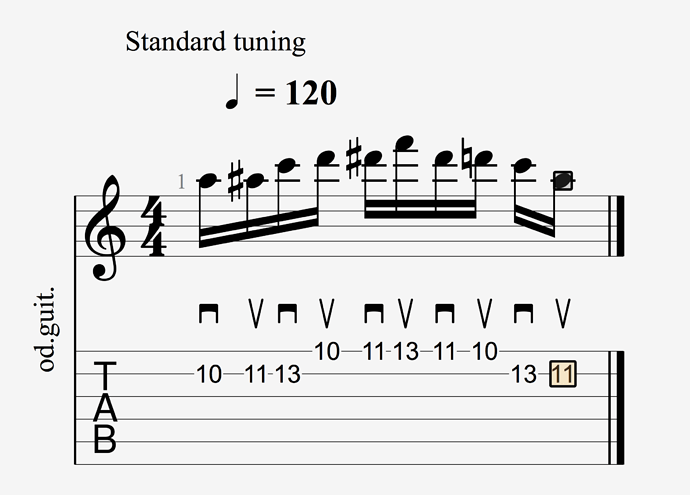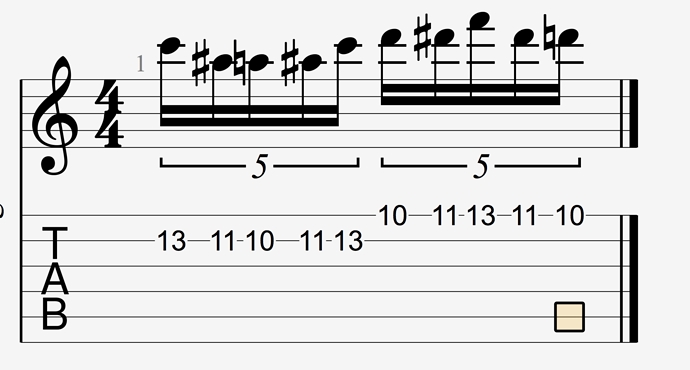These all look great! Technically, what you’re calling “forearm” looks like what my playing looks like when I use a mixture of wrist and forearm. Here’s what that looks like compared to just wrist motion:
Like almost all types of wrist/forearm blend motions I’ve seen, yours appears to be a USX motion. In fact, in the two string scale clip where you’re starting on a downstroke, I think you’re actually picking four notes on the lower string and six on the top string. This is something I call “displacement”.
What’s happening is that your hands have figured out that they need to play an even number of notes per string, to end on an upstroke. So they’ve shifted, or “displaced”, one of the pickstrokes to the upper string. Technically this is incorrect, because you’re not fretting that string. But… you are muting it with your fretting hand. So what happens is that you get the noise of pick attack hitting the muted note. When you put this together with the hammered-on note from the lower string (the note you were supposed to pick), it actually sounds like a complete picked note — just that the two parts, the pick attack and the pitch, are actually coming from two different strings.
Again, technically, this is a mistake, i.e. picking a different string than the one you are fretting. But because it feels like a picked note, and sounds (sort of) like a picked note, you don’t notice. You can even do the Paul Gilbert lick this way if you transfer one of the picked notes to the upper string. It’s totally wacky but you can do this intentionally and it’s a trip. I think a lot of players do this without realizing it.
The clip where you start on an upstroke is played somewhat more traditionally, with the usual number of pickstrokes per string. The last note on the top string would be the trouble note because that would be trapped in a USX motion. And it does look like you’re making a slightly different wrist motion on that note, again, because your hands have figured out that you have to get over the string somehow. It’s not clear that you’re actually getting over it — in some cases you might be. In other instances I think you’re picking it and then hitting it (swiping) on the way back, which is the little pick sizzle you can sometimes hear. In still other cases I think you might not actually be picking all the way through the string, and instead staying on the top side of it and pushing against it, causing the sound to drop out. I call this kind of picking error a “push” and it’s also very common. In a way though, this still an informed kind of error, if you think about it. This is your hands figuring out, amazingly, that this particular note needs special attention.
Anyway, the bottom line is this all still sounds pretty good to me. You have eliminated all but the two notes that don’t entirely fit with the motion you’re using and they have done a pretty good job of camouflaging what’s going on so that the lines still sound like the lines you’re intending to play. With more awareness you can try to do something to bring these notes back in a more traditional way. Or you could just forget about it and work on smoothness and building out more musical vocabulary, and only worry about it if doesn’t sound good on certain phrases.
For the wrist-only attempts, they look good too. Even though there may be some forearm in there still, it’s not particularly material. If you look at the way the hand is moving, it’s mostly moving along a wrist motion path, not a forearm path. If you try to incorporate these motions into casual playing, you may find that over time you’re better able to distinguish them by feel — to turn them on and off without thinking about it, and to be faster and smoother with them. Up to you.
As far as the double escape attempt, that doesn’t look particularly double escape to me, but I wouldn’t worry about that. I almost never try to do that motion on a single note on a single string. The only way I really know of to make sure I’m doing that motion is when I try to play lines where I would need it — either arpeggio stuff, or jazz / country / bluegrass lines with mixed notes per string. Otherwise, a cleanly picked “note” just sounds like a note and I really can’t tell by feel whether it’s really escaping. Even great double players like Martin Miller don’t actually appear to make a double escape motion when they’re playing single notes.
So, you have options. Nice work on all this!





 Starting to get the wrist motion smoothed out a little more now. Think my brain is finally listing to the commands
Starting to get the wrist motion smoothed out a little more now. Think my brain is finally listing to the commands 